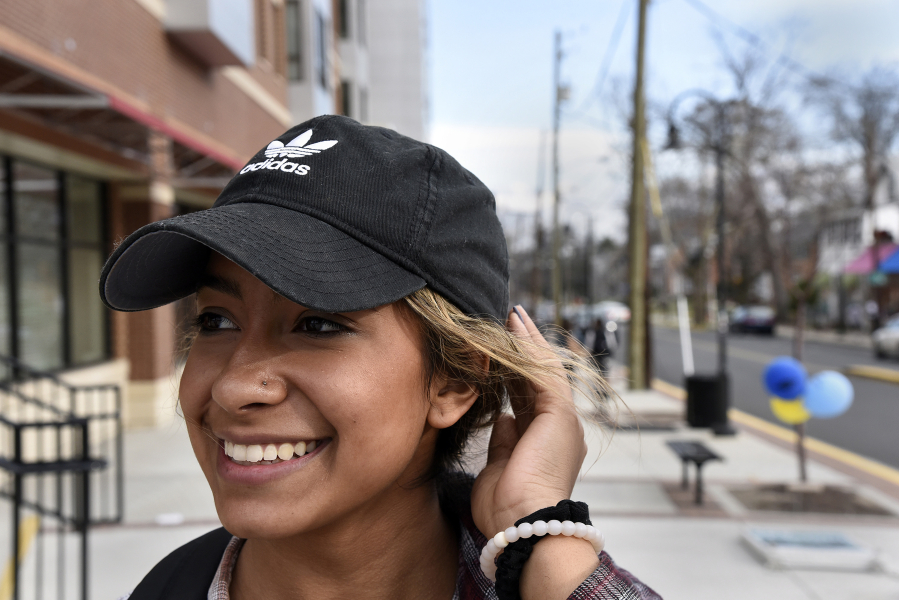BALTIMORE — A few years ago, Adidas was fading away in America like a tired 1970s rock band, its once-iconic three stripes producing more nostalgia than sales.
But the German sports brand found a more contemporary beat by partnering with rapper Kanye West and other pop culture icons and aggressively engaging its target audience of 14-to-24-year-olds where they live — on social media.
Suddenly, kids began buying the shoes their parents wore, now infused with retro chic. They bought them in such quantities that Adidas snuck up behind Under Armour and recaptured the No. 2 position in combined U.S. apparel and footwear sales from the Baltimore-based brand, according to an NDP Group analyst.
“It’s such a thing,” said Keli Reyes, a University of Maryland sophomore who wore white Adidas Superstar sneakers and a black Adidas ball cap as she walked on a recent afternoon at the school, where the athletic teams exclusively wear Under Armour.
Her friend, sophomore Remi Warner, also wore Superstars — a variation of the model that Mark King, Adidas’ North American president, said he wore in 1972. Adidas’ North American headquarters are in Portland.
It’s not just a retro feel that enabled 68-year-old Adidas — which is much older than rival athletic brands Nike and Under Armour — to mount a U.S. comeback. The company said it is more rapidly changing designs, colors and fabrics than before, catering to U.S. consumers accustomed to frequently seeing fresh looks.
“Until a couple years ago we probably hadn’t done as good of a job as we would have liked on a lot of different fronts,” said King, who became president of the North American division, in 2014. “And the first was making North America a real priority for the company.”
In 2014, Adidas collaborated with West on a sneakers and clothing line.
Singer Pharrell Williams also partnered with the brand. The next year, West unveiled his early Adidas designs at a New York Fashion Week event with pop celebrities Jay Z and Beyonc?, Diddy and Rihanna in attendance. In the next few years, actress Emma Stone, pop star Taylor Swift and singer-actor Justin Timberlake were all photographed wearing Adidas.
Adidas-wearing stars and company initiatives created a social media buzz. Adidas actively engages fans on social media, for example, creating a contest asking them to tweet images of themselves for possible use on the label of a popular shoe line.
“We’ve been really active in social media, which is where these 14-to-24-year-old lives their life,” King said. “I think it’s that constant availability that’s really driving the connection.”
Analysts say Adidas has been pulling domestic market share from industry leader Nike and Under Armour, whose stock price fell in January after it announced sales that missed Wall Street expectations and a forecast for 2017 that showed slowing growth. That came despite Under Armour’s reaching a record $4.8 billion in sales in 2016.
Under Armour, the youngest of the three brands, only overtook Adidas in the U.S. in 2014, according to a Sterne Agee report citing sales figures from SportScanInfo.
But last fall, Adidas climbed back into second, according to Matt Powell, a sports industry analyst with NPD Group, using figures based on the group’s retail tracking numbers.
The data showed striking gains by Adidas in footwear, Powell said. While the overall American footwear category grew in the low single digits in 2016, Adidas’ growth was more than 80 percent, he said.
“You need to go back in history,” Powell said. “Adidas had a history of not making products that American kids wanted to buy. They hit bottom in 2014. They really changed their approach to the U.S. market.”
In response to questions about the resurgent Adidas, Under Armour didn’t address its rival, but called itself a “growth company” focused on its domestic market.
The German company dwarfs Under Armour globally with $19.2 billion in revenue in 2015. Its North American sales were up 26 percent in 2016’s second quarter and 20 percent in the third quarter. Adidas will release fourth quarter results March 8.
It doesn’t matter to Adidas whether American buyers in their teens or 20s know that the Superstars originated in 1969 and that another popular line, the Stan Smith, was named for an American tennis champion in the 1970s.
“The consumer is always looking for something new and fresh, but for that young consumer the Stan Smith and the Superstar may be new to them,” said Jim Duffy, managing director of equity research for Stifel Financial Corp.



